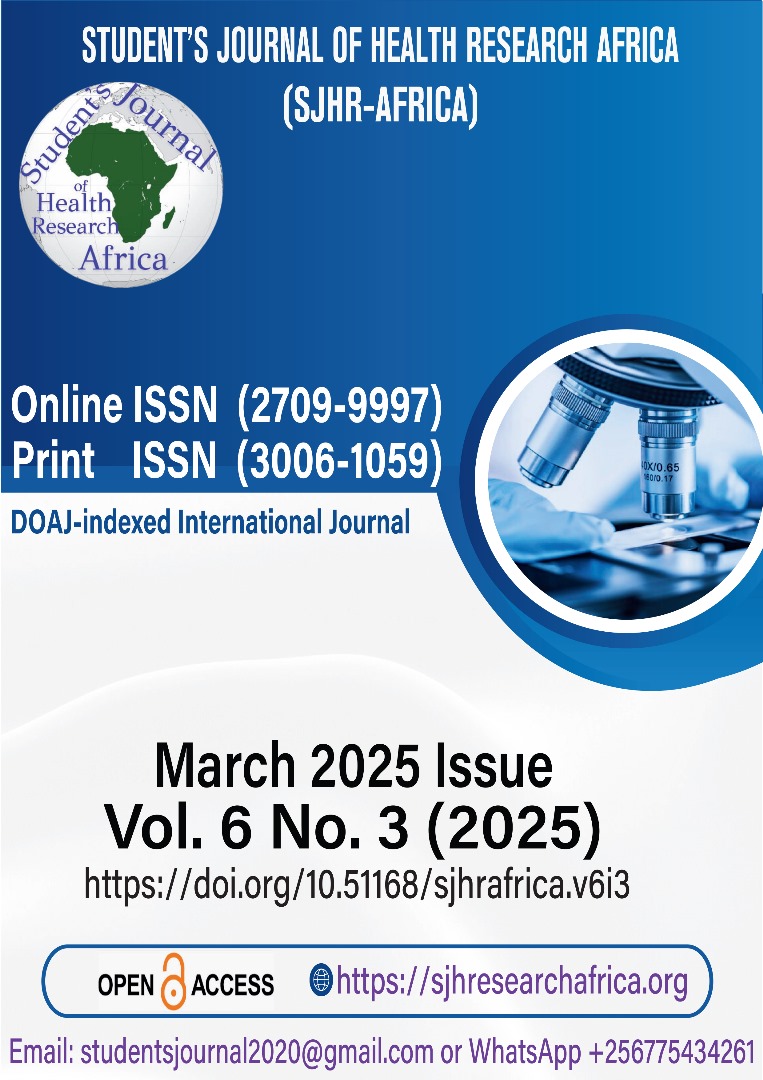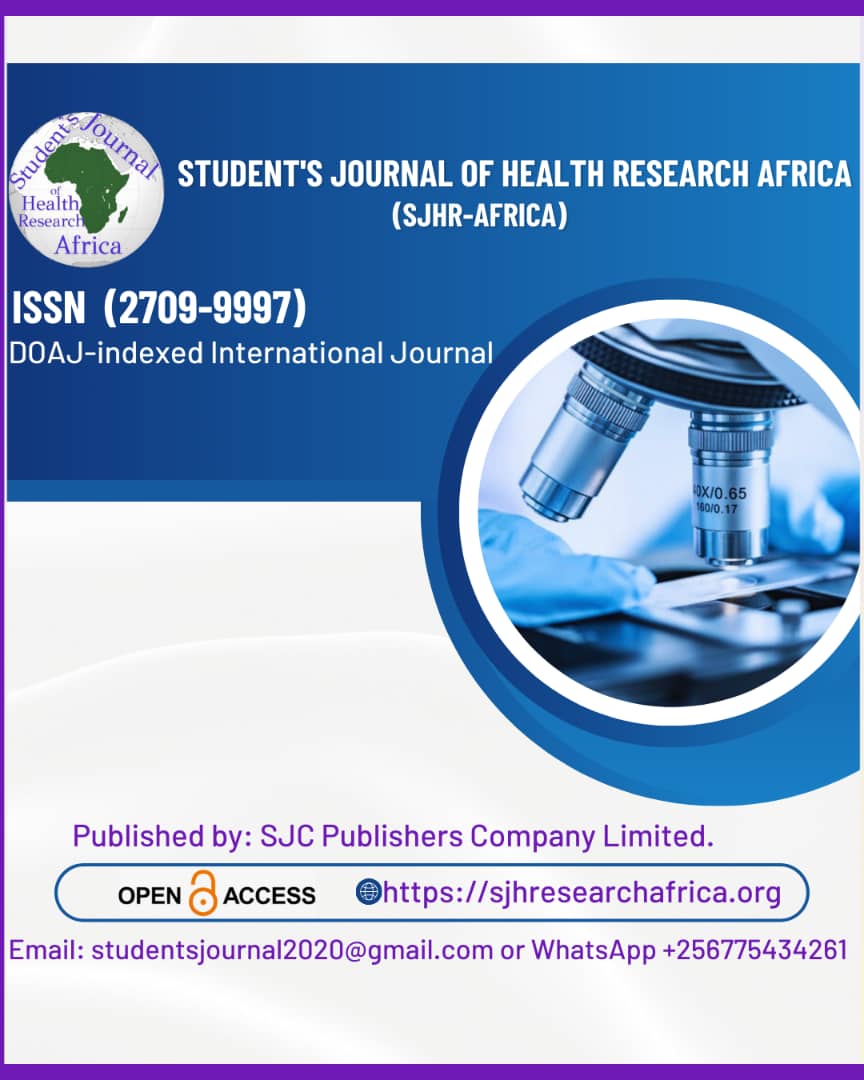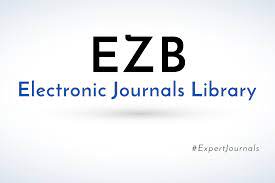FUNCTIONAL AND RADIOLOGICAL OUTCOMES OF UNCEMENTED TOTAL HIP ARTHROPLASTY: A PROSPECTIVE COHORT STUDY AT A TERTIARY CARE CENTER.
DOI:
https://doi.org/10.51168/sjhrafrica.v6i3.1744Keywords:
Uncemented Total Hip Arthroplasty, Functional Outcome, Modified Harris Hip Score, Radiological Assessment, OsteointegrationAbstract
Background
Uncemented total hip arthroplasty (THA) is increasingly preferred in younger patients due to its potential for long-term biological fixation and reduced cement-related complications. This study aimed to evaluate the functional and radiological outcomes of uncemented THA performed for various hip pathologies at a tertiary care center.
Materials and Methods
This prospective observational cohort study was conducted at Mahatma Gandhi Memorial Hospital, Warangal, and included 30 patients aged 20–60 years who underwent uncemented THA between September 2022 and August 2024. The mean age was 43.6 ± 9.2 years, with 56.6% males and 43.3% females. Clinical indications included chronic arthritis (53.3%), avascular necrosis (23.3%), femoral neck fractures with or without implant failure (19.9%), and developmental dysplasia of the hip (3.3%). Functional outcomes were assessed using the Modified Harris Hip Score (MHHS), and radiological outcomes focused on implant positioning and osteointegration.
Results
The mean MHHS improved significantly from a preoperative score of 46.2 ± 5.8 to a postoperative score of 85.6 ± 7.4 (p < 0.001), indicating substantial functional recovery. At final follow-up, 10% of patients had excellent functional outcomes (MHHS 90–100), 63.3% had good outcomes (80–89), 20% had fair outcomes (70–79), and 6.3% had poor outcomes (<70). Radiologically, 76.6% showed neutral femoral stem alignment, and 83.3% had optimally placed acetabular cups. Complication rates were low and manageable.
Conclusion
Uncemented THA provides significant functional improvement and satisfactory radiological outcomes with minimal complications. Proper patient selection, surgical technique, and structured rehabilitation are critical for optimal results.
Recommendations
Uncemented THA should include careful patient selection, accurate implant placement, and long-term follow-up to ensure functional success and stability.
References
Huo MH, Stockton KG, Mont MA, Bucholz RW. What's new in total hip arthroplasty. J Bone Joint SurgAm.2012;94(18):1721-1727. doi:10.2106/JBJS.L.00620
https://doi.org/10.2106/JBJS.L.00620PMid:22992882
Charnley J. Total hip replacement by low-friction arthroplasty. Clin Orthop Relat Res. 1970;(72):7-21.https://doi.org/10.1097/00003086-197009000-00003
Willert HG, Bertram H, Buchhorn GH. Osteolysis in alloarthroplasty of the hip: The role of ultra-high molecular weight polyethylene wear particles. Clin Orthop Relat Res. 1990;(258):95-107.https://doi.org/10.1097/00003086-199009000-00013
.Malchau H, Herberts P, Eisler T, Garellick G, Söderman P. The Swedish Total Hip Replacement Register. J Bone Joint Surg Am. 2002;84-A(Suppl 2):2-20. doi:10.2106/00004623-2002-84-2-2
https://doi.org/10.2106/00004623-200200002-00002PMid:12479335
Glyn-Jones S, Palmer AJR, Agricola R, et al. Osteoarthritis. Lancet. 2015;386(9991):376-387. doi:10.1016/S0140-6736(14)60802-3https://doi.org/10.1016/S0140-6736(14)60802-3PMid:25748615
.Engh CA, Bobyn JD, Glassman AH. Porous-coated hip replacement: The factors governing bone ingrowth, stress shielding, and clinical results. Clin Orthop Relat Res. 1987;(225):123-130.
Dorr LD, Kane TJ 3rd, Conaty JP. Long-term results of cemented total hip arthroplasty in patients 45 years old or younger: A 16-year follow-up study. J Arthroplasty. 1994;9(5):453-456. doi:10.1016/0883-5403(94)90118-X
https://doi.org/10.1016/0883-5403(94)90118-XPMid:7699377
Inoue D, Kabata T, Maeda T, et al. Long-term results of cementless total hip arthroplasty with a titanium alloy stem: A minimum 20-year follow-up study. J Orthop Sci. 2019;24(5):850-855. doi:10.1016/j.jos.2019.01.014
https://doi.org/10.1016/j.jos.2019.01.014
PMid:30777362
Learmonth ID, Young C, Rorabeck C. The operation of the century: Total hip replacement. Lancet.2007;370(9597):1508-1519. doi:10.1016/S0140-6736(07)60457-7https://doi.org/10.1016/S0140-6736(07)60457-7PMid:17964352
Sariali E, Mouttet A, Pasquier G, Durante E. Intraoperative complications and learning curve in uncemented total hip arthroplasty. J Arthroplasty. 2014;29(7):1404-1409. doi:10.1016/j.arth.2013.12.030
https://doi.org/10.1016/j.arth.2013.12.030PMid:24524774
.Lakhotia D, Agrawal U. Functional Outcome of Uncemented Total Hip Replacement in Low Socioeconomic Group Using Modified Harris Hip Score: A Prospective Midterm Follow-Up Study. Cureus.2023;15(12):e50005. doi:10.7759/cureus.50005https://doi.org/10.7759/cureus.50005PMid:38186535 PMCid:PMC10767156
Marappa G, Shivalingappa VM, Jagadeesh N, Mandri A. A prospective study on functional outcome of uncemented total hip arthroplasty in patients with inflammatory arthropathies. Int J Res Orthop. 2020;6(3):622-627. doi:10.18203/issn.2455-4510.IntJResOrthop20201520
https://doi.org/10.18203/issn.2455-4510.IntJResOrthop20201520
Schuh A, Salminen S, et al. The cementless Vector stem in total hip arthroplasty. SOT. 2002;25(2):179-181.
Srinivasan V, et al. Assessment of Outcome of Uncemented Total Hip Arthroplasty. J Bone Joint Dis. 2022;37(2).
https://doi.org/10.4103/jbjd.jbjd_11_22
Bourne RB, Rorabeck CH, et al. A critical look at uncemented stem. Clin Orthop Relat Res. 1998;(355):212-223.
https://doi.org/10.1097/00003086-199810000-00022
Goyal D, Bansal M, Lamoria R. Comparative Study of Functional Outcome of Cemented and Uncemented Total Hip Replacement. J Orthop Traumatol Rehabil. 2018;10(1):23-28. doi:10.4103/jotr.jotr_10_18
https://doi.org/10.4103/jotr.jotr_10_18
Kumar R, Yadav R, et al. Functional outcome after total hip replacement surgery. Int J Res Orthop. 2023;9(1):45-49.
https://doi.org/10.18203/issn.2455-4510.IntJResOrthop20232608
Downloads
Published
How to Cite
Issue
Section
License
Copyright (c) 2025 Dr. Mukara Prakash, Banna Kiran Kumar, Dr. Nagaraju koppula, Dr. Badam Swikrutha, Dr. Kannan Dinesh

This work is licensed under a Creative Commons Attribution-NonCommercial-NoDerivatives 4.0 International License.






















